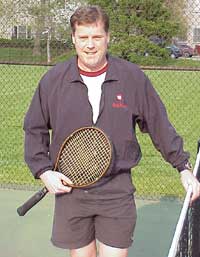Understanding Professional
Forehands: Part 2
Dr. Brian Gordon
In my previous article (Four Pillars of the ATP Type III Forehand) I presented a "best practice" guide for hitting a forehand based on my research and work on the court. (Click Here.) In the first article of this two-part series for the September issue, I covered concepts not addressed in that presentation. Specifically, I discussed the backswing and the implication of a bent elbow in the forward swing. (Click Here.)
The Four Pillars article, combined with the concepts from Part 1 of this article, should provide a mechanical framework to better understand many forehand options. So now let's see how these concepts apply to a number of forehands on both professional tours. I break them down into 4 categories:
Forehand Categories
- The ATP Type III Forehand
- The ATP Classical Forehand
- The ATP Modern Forehand
- The WTA Type II Forehand
The Type III Forehand
The Type III Forehand by definition conforms to the pillars of the Type III model. It is a well linearized stroke with significant independent motion of the hitting arm and clear rotation sequencing. External shoulder rotation in the external to internal coupling mechanism is driven by the racquet in the "flip". The elbow is maintained straight (180 degrees) and the backswing type is Positional.
Roger Federer and Rafael Nadal are perhaps the best examples of this type. I think many would agree these players have the best forehands on the planet if not in history. Observers have noted some obvious differences in terms of the grips, the backswings, and the finishes. Based on the core mechanics, however, these forehands are very similar by my definition.
The ATP Classical Forehand
This is the most common forehand style on the men's tour and it is becoming more prevalent on the women's as well. It utilizes an outside oriented hand and racquet position entering the forward swing, so it is moderately linear. The primary difference from the Type III forehand is that the elbow is bent. This minimizes independent arm motion, alters the shoulder external rotation mechanism, and generally requires a Functional backswing.
Novak Djokovic and Dominic Thiem are very good examples of this type. Analogous to the Federer/Nadal comparison, these strokes are very similar in the core mechanical components. Thiem does maintain a more bent elbow which is the most significant difference. Interestingly, in a recent video (Western and Southern practice) he appears to have changed his forehand in important ways including the elbow angle.
The ATP Modern Forehand
The ATP Modern Forehand is the most recent development in tour forehand styles. It utilizes an outside hand and racquet position entering the forward swing but the racquet is far more outside than the other types. The elbow tends to be very bent minimizing independent arm motion and moving rotation sequencing toward a unit rotation. Shoulder external rotation is primarily muscularly driven which is the most significant difference with the other ATP types. The backswing is Positional.
Jack Sock seems to be one of the pioneers. Nick Kyrgios is often cited as an example of this modern style forehand. However, based on close examination of his transition to the forward swing it is pretty clear his is a hybrid of the Classical and Modern styles. My opinion is that the pure modern type is far too complicated, cumbersome and potentially dangerous. I believe it will be short-lived and I would not teach it to my players.
The WTA Type II Forehand
The WTA Type II forehand is the most common on the WTA tour. The fundamental difference with all ATP types is the inside racquet position entering the forward swing. The reason for this is shoulder external rotation occurs during the backswing rather than during the forward swing like the ATP types. It is a circular swing type with a bent elbow and minimal independent arm motion so the body and arm rotate in tandem (no sequencing). The backswing is the most Functional of all types included here.
Garbine Muguruza and Simona Halep are typical examples of the WTA Type II forehand style. This stroke has held up well at the highest level of women's tennis for a very long time. I've pointed out though that I believe this swing type is on its way out. The reason is that it is best suited for hitting hard and flat (little variability) and does not have great solutions for certain incoming shots like higher balls. Halep is included here as a high contact example.
Summary Table
The primary forehand types have been briefly described in terms of their mechanics in this part of the article. Analysis of strokes was based on concepts of the previous Four Pillars article and Part 1 of this article. Obviously within each type we see some variability but (I think) a general adherence to the group attributes. The group attributes based on the previous articles are summarized below:
| ATP - Type III | ATP - Classical | ATP - Modern | WTA - Type II | |
|---|---|---|---|---|
| Backswing Type |
Positional | Functional | Positional | Functional |
| Forward Swing Entry |
Racquet Ouside | Racquet Ouside | Racquet FAR Ouside | Racket Inside |
| Elbow Angle | 165-180 Degrees |
120-165 Degrees |
120-165 Degrees |
90-120 Degrees |
| Fractionation | Maximal | Moderate (Variable) |
Moderate (Variable) |
Minimal |
| Independent Arm Motion |
Maximal | Moderate (Variable) |
Moderate (Variable) |
Minimal |
| Rotation Sequencing | Distinct 3 Link |
Variable 2-3 Link |
Variable 2-3 Link |
Unit Rotation |
| Linearization | Linear | Linear Early |
Linear Early |
Circular |
| Neuromuscular ESR Source |
Motion Dependent | Inertial | Muscular | Backswing Loop |




